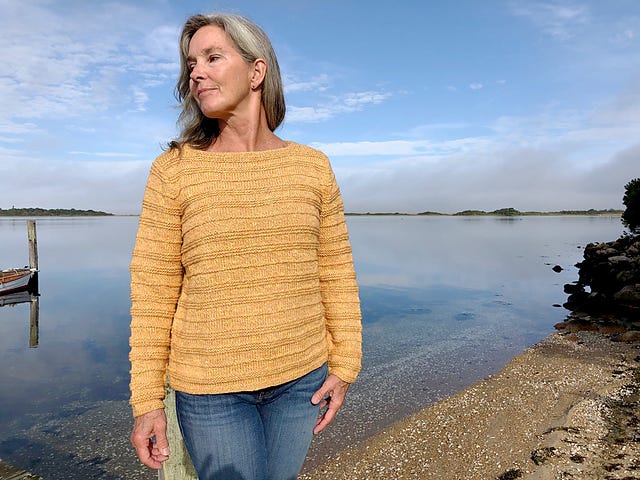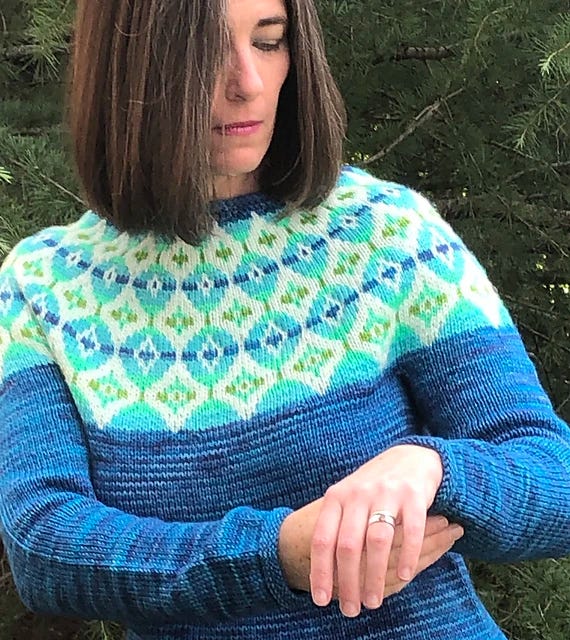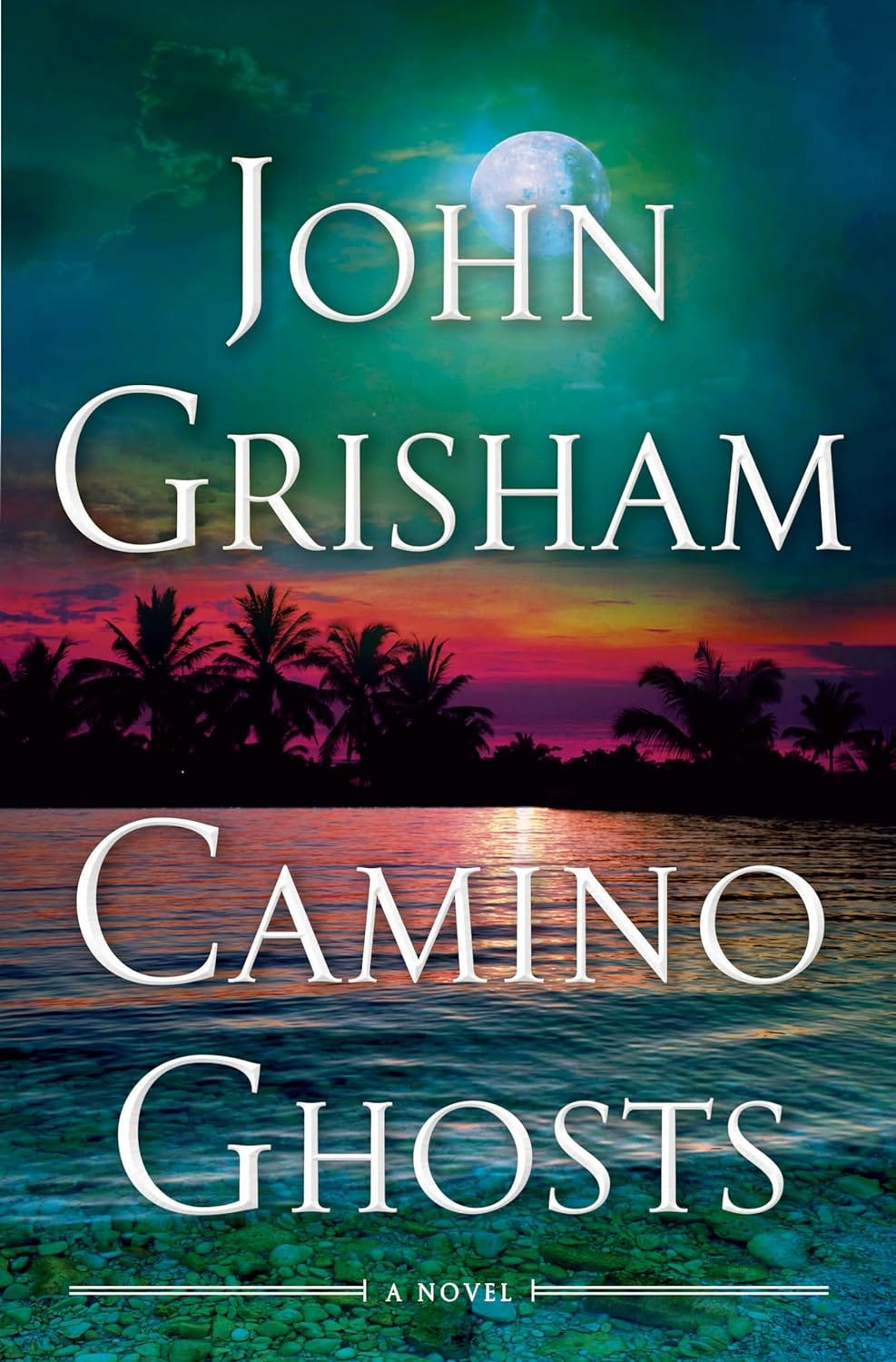A couple of weeks ago, I wrote about the process of submitting knitting designs to yarn companies, magazines, or other publishers. Several readers expressed interest in the rest of the process—taking the design through to the published pattern.

This week, I'm writing about how I turn a design idea into a knitted sample and a written pattern ready to deliver to the publisher. In the weeks to come, I'll write about how the publisher turns that into a finished knitting pattern. I'll also write about why I prefer to work with yarn companies and magazines instead of self-publishing my designs.
Yarn Selection
When we left off, my design submission had been accepted and contract terms had been agreed. Now I wait for the yarn to arrive.
It may surprise you to know that the designer often does not choose the yarn and color(s) used to create the design. The yarn company may have specific yarns they want to promote with the collection. A magazine may want to use yarns supplied by an advertiser. The publisher may have selected an overall color palette to support the theme of the collection. Or maybe the colors you asked for are simply not in stock.
This does not mean that you're stuck with whatever the publisher sends. Magazine publishers are often selecting yarns from websites without ever having seen the yarn in person. Not every yarn works well with every design, and not every color combination sings. Perhaps the texture of the yarn obscures the stitch pattern. Maybe the colorwork motif needs more contrast. When I'm disappointed with how a yarn or color combination is working out, I send a photo to the editor and discuss options.
The Real Work Begins
Once the yarn arrives, I begin by making a generously sized swatch (at least 6" x 6") of each stitch pattern used in the design. Yes, I made swatches as part of my design submission, but those swatches probably weren't made with the yarn assigned for the final design. I wash and block the swatches in the same way I expect to treat the finished garment. Then I measure and record stitch and row gauge for each stitch pattern.
Time to Do the Math

Now that I have my gauge(s), I can work out the numbers. I create an Excel spreadsheet and use it to calculate stitch counts, row counts, and shaping for all the sizes. Calculating numbers for a range of sizes is called "grading".
Some designers knit the sample before working out the grading. I do all the math first, because I don't want to design something that won't work across the full range of sizes. In recent years, consumer demand has pushed the industry to offer patterns in a much more inclusive size range (long overdue). The current expectation is that sizes for an adult garment will range from about 32" to 62" (or larger) finished chest circumference. Most publishers expect the designer to handle the grading.
Grading is often a challenge for designers. We all begin by designing for the body we know best: our own. We may not be aware of how proportions shift as chest circumference changes. If you are looking for a good size chart reference, I recommend you pick up a copy of The Knitting Pattern Writing Handbook by Kristina McGrath and Sarah Walworth. Along with a motherload of solid gold information, this book has great size charts for women, children, and men.
I also create all the stitch pattern or colorwork charts at this point. I use Adobe Illustrator to draw charts and schematics.
Now We Knit
I highlight the column of numbers for the sample size (which is never "my " size, and probably won't be "your" size unless you have a 34" bust) and print the spreadsheet and the charts.
Finally, we're ready to cast on for the sample. I knit the sample using the numbers from my spreadsheet, making lots of notes along the way about the techniques I use and any adjustments or deviations from the spreadsheet. In almost all cases, this sample will be used for the photos in the pattern, so it must look good, and it must match the finished pattern. When I'm knitting just for me, I might fudge the numbers or ignore a small error, but this is not acceptable when knitting for publication.
Some people assume that every design is test knit in every size. While some designers engage in extensive testing of independently published patterns, this is rarely the case for magazines and yarn companies. In most cases, the sample knit by the designer is the one and only sample made before the pattern is published. Testing is expensive and adds months to the production process.
Writing the Pattern
Once the sample is complete, I double check my gauge, adjusting my spreadsheet if necessary to make sure the pattern will accurately represent the finished sample.
In most cases, the publisher provides a style sheet, which details their preferred format for patterns. I follow the style sheet as closely as possible as I write the pattern. Some designers ignore the style sheet, using their own preferred pattern-writing format. Having worked on the publisher’s side, I know that when designers ignore the style sheet the cost of tech editing increases. As a publisher, I'd be willing to pay a little more for a designer who helps keep my editing costs down.
As I write the pattern, I incorporate the notes I made while knitting the sample. I make any necessary corrections to the charts. I draw the schematic using Adobe Illustrator. Then I send the pattern, charts, and schematic to the publisher, and ship the sample.

Next time, I'll talk about all the work that happens on the publisher's side: tech editing, photography, layout, and publication.
Once again, I'm running long (too long? Do you wish these posts were shorter? Let me know!), so here is a quick book recommendation. I'm about 2/3 of the way through John Grisham's new novel, Camino Ghosts.
This is the third book in Grisham's series about Camino Island and bookstore owner Bruce Cable. Unlike Grisham's usual legal thrillers, this has some elements of a ghost story, and I'm here for it. As a special treat, the audiobook is read by none other than Whoopi Goldberg. She's a terrific reader, and her deep voice makes this book come alive.
Book title links are affiliate links for Bookshop.org, a non-profit that supports independent bookstores. If you make a purchase through these links, I will earn a small commission at no additional cost to you
If you've read all the way to the end, thank you! I appreciate your giving me your time and attention. If you have questions about the design process, be sure to leave a comment. This series of posts was suggested by a subscriber (thanks,
), and I love hearing from you.





Fascinating read! Thank-you for sharing a behind the scenes look at having a pattern published. It was interesting to learn about only one size will be test knit because of the cost involved in test knitting multiple sizes. Years ago I heard a knitwear designer give a talk in which she said she no longer enjoyed knitting! I was flabbergasted at her admonition. Do you find you enjoy the pattern design or the knitting of the sample more in this process? I'm curious. Thanks!
Such good info Sandi. Thank you for sharing it all. I have ordered the Handbook. How easy did you find Adobe to work with for your needs?